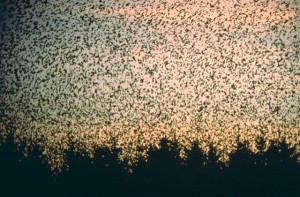Impacts on Birds
Module 6: Birds provided the following learning outcomes:
- Certain distinctive features make birds unique as living organisms;
- Specific morphological features can separate animals into different taxonomic groupings even when they appear similar;
- Birds have evolved different morphologies to help them attain food;
- Not all birds fly, and not all flying creatures are birds;
- The flight mechanisms of different animals may differ widely;
- Different birds eat different foods;
- Different birds live in different habitats;
- Habitat can be both spatial and temporal;
- Changing your backyard can make it more appealing to different types of birds;
- Climate change has already affected many different kinds of birds;
- Continued climate change will affect many more birds as habitats change;
- You can build nest boxes that can attract different types of birds;
- You can use bird feeders to attract birds to your backyard;
- You can identify birds based on their songs.
As you worked through this module, you learned about the various physiological features that helped to define avians, as well as many of their behavioral traits and strategies. In addition to these “bird facts”, a number of articles and features suggested that birds are part of an evolving landscape, and that many of the changes occurring to their environments demand changes in their behavioral strategies. These articles also suggested that humans can have a profound effect on the success of bird species, and that human behavior can both help and harm our feathered friends.
With the information you learned in Module 6, consider the following scenarios and discuss the results of human impacts on birds – and on humans as well. Should we take measures to mitigate these impacts, or allow birds to adjust to human needs and behaviors? Visit the Forum: Impacts on Birds to discuss these examples, or leave a comment below to get feedback from the MSP team.
- Humans are famous (or infamous) for playing God in the wilderness by trying to manage which species are present in a particular area, whether or not they are native species. A dramatic example of this phenomenon was the introduction of the European starling in 1890 to Central Park, New York. Eugene Schieffelin wanted to introduce every bird mentioned in the works of William Shakespeare to North America. In 1890 he released 60 birds. The starlings have been very successful, with over 200 million in North America today.
- The Hawaiian nene (goose) was once quite common, with close to 30,000 geese on the Hawaiian islands when Captain James Cook arrived in 1778. Since that time, the introduction of the mongoose to control rat populations (introduced by humans) and feral pig populations (introduced by Polynesians), as well as loss of habitat to development, reduced the population to 30 birds in 1952.
- The use of pesticides like DDT was considered critical in eradicating insect pests that carried deadly human diseases such as malaria and typhus. Widespread use of DDT was effective in reducing mosquito populations for several years. Swiss chemist Paul Hermann Muller was awarded the Nobel prize in Physiology or Medicine in 1948 for his discovery that DDT could be used as an effective arthropod poison. The use of this pesticide was discontinued when it was found to be the cause of declining populations of birds in the twentieth century.
- Local development can adversely affect certain bird species. Consider ways that humans can help mitigate these effects. What are the potential problems with human intervention?
